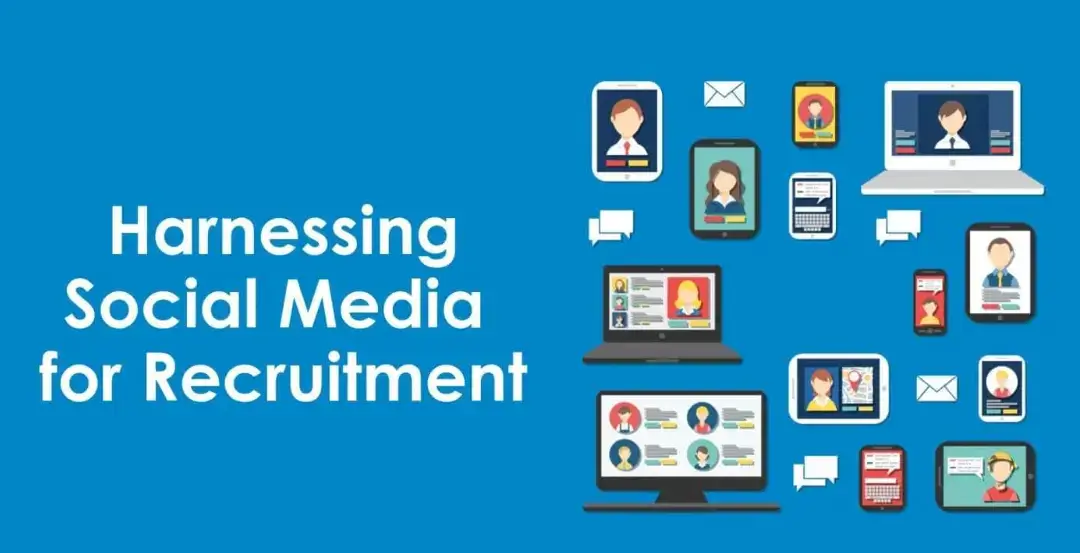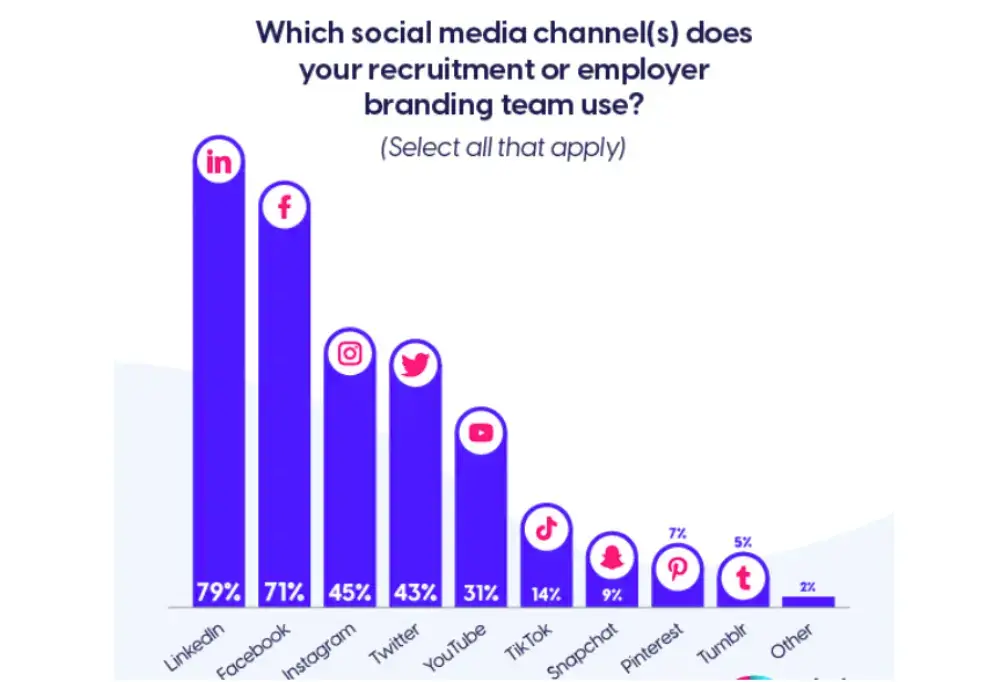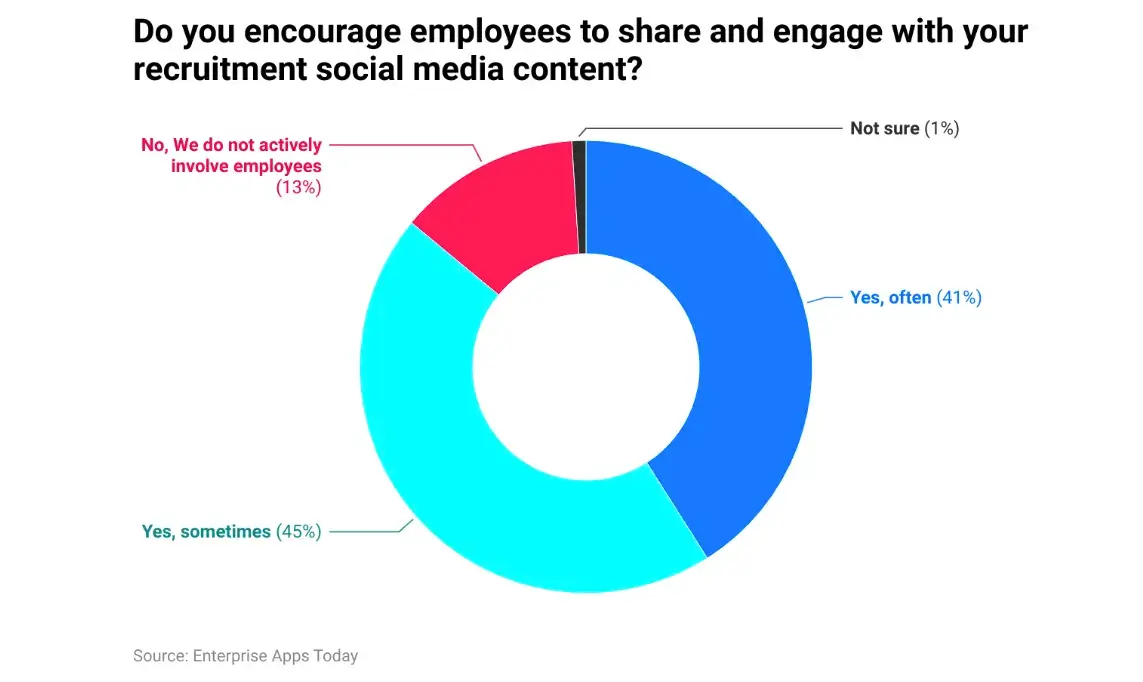Social media has become integral to our lives, connecting us with people, information, and opportunities worldwide. It is also a powerful tool for businesses, especially recruitment and branding.
Whether you’re a seasoned HR professional or a business owner, you might want to use social media to increase your reach and attract more qualified and diverse candidates for your open positions.
This article will provide practical tips and strategies for leveraging social media for recruitment and branding effectively and ethically.
Shortcuts:
- The Role of Social Media in Recruitment and Branding
- Elements of the Right Platform
- Which Social Media Platforms to Use
- Creating and Sharing Relevant Content
- Encouraging Employee Advocacy
- Interacting and Communicating with the Audience
- Monitoring and Analyzing Metrics
- Challenges to Consider

How To Use Social Media for Recruitment and Branding
Social media plays a vital role in recruitment and branding, as it can help you reach and engage a broader and more diverse audience.
However, you need to follow these practices to leverage social media effectively and ethically.
1. The Role of Social Media in Recruitment and Branding

Credit: TalentLyft
“Social media is a platform for entertainment and communication and a powerful tool for recruitment and branding,” adds Derek Bruce, Operations Director at Skills Training Group.
By using social media, you can:
-
Reach a broader and more diverse audience.
Social media allows you to access and connect with millions of potential candidates and customers worldwide who may not be aware of or interested in your company otherwise.
“You can use social media to showcase your company and its offerings and to attract and engage your target audience,” said David Martinez, VP of Enterprise & OEM Accounts at Cybernet Manufacturing.
-
Enhance your employer reputation and image.
Social media allows you to build and promote your employer brand, which is your company's perception and reputation as a workplace.
"You can use social media to communicate and demonstrate your employer value proposition, the unique benefits, and opportunities you offer your employees and potential candidates," said Michael Hess, Tech Expert at Code Signing Store.
-
Attract and retain talent.
Social media allows you to recruit and retain talent who are the most valuable assets of your company.
You can use social media to post job openings, provide helpful information and insights, answer questions, and address concerns.
“You can also use social media to give feedback and recognition, to celebrate milestones and successes, and to foster loyalty and advocacy,” shares Gerrid Smith, CMO of Joy Organics.
-
Build trust and loyalty.
Social media allows you to interact and communicate with your audience effectively and professionally.
You can use social media to establish and maintain a positive and lasting relationship with your audience and to show them that you care about them and value their opinions.
“You can also use social media to address feedback and complaints and to manage online reputation and crisis,” explains Maria Mercieca Imbroll, Team Leader of Corporate Services at CSB Group.
2. Elements of the Right Platform
The first step to leveraging social media for recruitment and branding is to choose the most suitable and effective platforms for your goals and objectives.
Many social media platforms are available, each with its own features, strengths, weaknesses, and audience.
You need to consider the following factors when selecting a platform.
-
Target audience
Identify where your potential candidates and customers are most active.
LinkedIn might be ideal for professional networking, while Instagram or TikTok may cater to a younger, more visually oriented audience.
-
Content type and format
Different platforms support diverse content formats. Consider the nature of your content—visual, text-based, or multimedia—and align it with platforms that showcase such content effectively.
-
Goals and objectives
Define your goals clearly. If it's about professional connections, LinkedIn may be your go-to. For a broader audience reach, Facebook or Instagram might be more suitable.
-
Budget and resources
Evaluate your budget constraints and resource availability. Some platforms may require more financial investment, while others demand consistent creative resources.
-
Competitors and trends
Keep an eye on competitors and industry trends. Understand where similar businesses are finding success and adapt your strategy accordingly.
3. Which Social Media Platforms To Use

Image Credit: Content Stadium
Depending on the company's goals, objectives, and target audience, you can use many social media platforms for recruitment and branding.
Some of the most popular and widely used platforms are:
-
LinkedIn
LinkedIn is the world's largest and most popular professional network, with over 740 million members in more than 200 countries.
It is the ideal platform for showcasing your employer brand, attracting and engaging talent, and building your network and reputation.
You can use LinkedIn to create a company page, post job openings, share company news and updates, and showcase employee stories and testimonials.
-
Facebook
Facebook is the world's largest and most popular social network, with over 2.8 billion monthly active users in more than 180 countries.
It is a versatile and flexible platform for creating and sharing various types of content, such as videos, images, podcasts, blogs, infographics, webinars, and live streams.
You can use Facebook to create a company page, post job openings, share company news and updates, showcase company culture and values, and provide helpful information and insights.
-
X (formerly Twitter)
Twitter is one of the most popular and widely used microblogging platforms globally, with over 330 million monthly active users in more than 190 countries.
It is a fast and dynamic platform for sharing and receiving real-time information, news, and opinions.
You can use Twitter to create a company profile, post job openings, share company news and updates, showcase company culture and values, provide helpful information and insights, and join and create hashtags.
4. Creating and Sharing Relevant Content

Image Credit: Enterprise Apps Today
The above chart shows that most companies (86%) involve their employees in some way in their social media recruitment efforts, while only 13% do not.
Said Joe Cronin, President of International Citizens Insurance, “One of the most important aspects of leveraging social media for recruitment and branding is creating and sharing relevant content that showcases your employer brand and attracts potential candidates.”
By creating and sharing relevant content, you can.
-
Showcase your EVP (Employer Value Proposition)
Your employer value proposition (EVP) is the unique benefits and opportunities you offer your employees and potential candidates.
It is what makes you different and desirable as an employer.
Travis Kliever, Global Business Development Advisor at RemotePad, said, “You can use social media to communicate and demonstrate your EVP, such as your mission, vision, values, goals, culture, products, services, and impact. You can use content to highlight your EVP elements, such as your work environment, compensation and benefits, learning and development, recognition and rewards, and social responsibility.”
-
Highlight your company culture and values.
Your company culture and values are the core of your employer brand. They are the shared beliefs, behaviors, and norms that define who you are and how you work as a company.
Josef Eines, SEO Specialist at FORNYE, shares, “You can use social media to showcase your company culture and values, such as your diversity and inclusion, innovation and creativity, collaboration and teamwork, and fun and wellness.”
-
Showcase your employee stories and testimonials.
Your employee stories and testimonials are the most authentic and credible sources of information about your employer brand.
They are the personal and professional experiences and opinions of current and former employees, who can act as brand ambassadors and advocates.
Lais Schulz, Content Strategist at Befreela, says, “You can use social media to showcase your employee stories and testimonials, such as their career journeys, challenges and successes, feedback and suggestions, and referrals and recommendations.”
-
Provide helpful information and insights.
Your helpful information and insights are valuable and relevant knowledge and expertise you can offer your audience.
They are the educational and informative content that can help your audience solve their problems, answer their questions, and achieve their goals.
Sumeer Kaur, Founder of Indian Dresses, said, “You can use social media to provide useful information and insights, such as your industry trends and insights, best practices and tips, case studies and examples, and research and data.”
5. Encouraging Employee Advocacy
Turning your employees into enthusiastic brand ambassadors is a powerful strategy for amplifying recruitment and branding efforts.
“By harnessing the collective voice of your workforce, you not only enhance your organization's reach but also inject authenticity into your brand messaging,” adds Martin Seeley, CEO of Mattress Next Day.
-
Foster a culture of advocacy.
Cultivate an organizational culture that values and encourages employee advocacy.
When employees feel empowered and proud of their workplace, they are more likely to organically share their experiences, achievements, and the positive aspects of the company culture.
-
Provide shareable content.
Supply your employees with easily shareable content. It can include company updates, job openings, achievements, and engaging snippets of daily work life.
Make it effortless for them to share this content across their social networks, creating a ripple effect that extends your brand's visibility.
-
Highlight employee stories.
Spotlight individual employee stories to showcase the diversity and talent within your organization.
Personal narratives provide a human touch to your brand, making it relatable to potential candidates.
Feature employee testimonials, success stories, and behind-the-scenes glimpses to capture your audience's attention.
-
Leverage employee networks.
Encourage employees to share company updates within their professional networks.
It extends the organic reach of your content and taps into networks that might not be easily accessible through traditional marketing channels.
-
Recognize and reward advocacy.
Acknowledge and appreciate employees who actively participate in advocacy efforts.
Recognizing their contributions, whether through internal communications or small rewards, reinforces the value of their role in building the company's online presence.
-
Provide advocacy guidelines.
Offer clear guidelines on what is appropriate to share and how employees can contribute to the company's online presence.
Providing training or resources on practical social media usage ensures that advocacy efforts align with the overall branding strategy.
-
Showcase employee benefits.
Highlight the unique benefits of working at your organization. Sometimes, it’s the little things that can sway an interested candidate in working for your company.
Whether professional development opportunities, wellness programs, or unique workplace perks, emphasizing these aspects through employee advocacy can attract like-minded individuals who align with your company culture.
6. Interacting and Communicating with Your Audience
Building a thriving online community is a cornerstone of effective social media strategies for both recruitment and branding.
“Engaging with your audience on a deeper level fosters a sense of connection, loyalty, and a positive perception of your organization,” said Julia Dunlea, VP of Marketing at Akkio.
-
Initiate conversations
Actively seek out opportunities to start meaningful conversations. Pose thought-provoking questions, share industry insights, or invite opinions on relevant topics.
By initiating dialogue, you showcase your industry expertise and create a space for your audience to engage with your brand.
-
Respond promptly
Timely responses to comments, messages, and mentions demonstrate attentiveness.
Whether it's a question about a job opening or a comment on a recent company update, prompt responses show that you value and prioritize your audience's input.
-
Create and participate in discussions
Join industry-related discussions and communities. Share your organization's perspective, contribute valuable insights, and connect with professionals in your field.
Participating in discussions positions your brand as an authoritative voice within the industry.
-
UGC (User-Generated Content)
Encourage your audience to share their experiences and perspectives. It can include employees sharing their workday routines, participating in challenges, or submitting testimonials.
User-generated content not only showcases authenticity but also involves your audience in shaping your brand's narrative.
-
Share behind-the-scenes content
Offer glimpses into the daily workings of your organization. Share photos or short video clips of what life is like at your company.
Whether showcasing team collaborations, project milestones, or celebrating achievements, behind-the-scenes content humanizes your brand and allows your audience to connect with the people behind the company.
-
Run contests and giveaways
Engage your audience with interactive contests or giveaways. It not only attracts attention but also encourages active participation.
Tailor these initiatives to align with your branding messages, creating a positive association between your organization and the community.
-
Feature employee spotlights
Regularly highlight individual employees, their achievements, and contributions.
Employee spotlights celebrate your team members and provide a personal touch to your brand, making it more relatable to your audience.
7. Monitoring and Analyzing Metrics
Once your social media strategies are in motion, it's imperative to delve into the metrics that illuminate the effectiveness of your efforts.
Anthony Milia, Award-Winning Digital Marketer and Author at Milia Marketing, said,
“Monitoring and analyzing key performance indicators (KPIs) not only measure the success of your recruitment and branding initiatives but also provide invaluable insights for refining and optimizing your future strategies.”
-
Define relevant metrics
Begin by identifying the metrics most pertinent to your goals. For recruitment, track metrics such as application click-through rates, the quality of applicants, and time-to-hire.
Branding efforts may focus on metrics like engagement rates, follower growth, and sentiment analysis. Clearly defined metrics align with your objectives, allowing for targeted analysis.
-
Utilize platform analytics
Leverage the analytics tools provided by each social media platform. Platforms like LinkedIn, Twitter, and Facebook offer insights into reach, engagement, and demographic data.
Regularly review these analytics to understand which content resonates most with your audience and on which platforms your efforts are most effective.
-
Track conversion rates
For recruitment, closely monitor conversion rates from social media channels to your careers page or application forms.
Understanding the journey from social media engagement to application submission provides insights into the effectiveness of your recruitment funnel.
-
Measure brand sentiment
Utilize sentiment analysis tools to gauge how your brand is perceived. Positive sentiment indicates a favorable response to your branding efforts, while negative sentiment signals areas needing attention.
Regular sentiment tracking allows for proactive reputation management.
-
Assess engagement and interaction
Evaluate engagement metrics such as likes, comments, and shares. These indicators reflect the level of interaction your content generates.
Analyzing the types of content that garner the most engagement helps refine your content strategy for maximum impact.
-
Monitor follower growth
Follower growth provides insights into the overall appeal and relevance of your content.
A steady increase in followers indicates a growing audience that finds value in your brand. Sudden drops may signal the need for adjustments in content or strategy.
-
Conduct A/B testing
Implement A/B testing to experiment with different content formats, posting times, and messaging approaches.
A/B testing can identify the most effective strategies and refine your tactics based on real-time data.
-
Regularly review and adjust
Metrics are dynamic, and trends can change. Regularly review your analytics and be prepared to adjust your strategies based on the evolving landscape.
Continuous improvement based on data-driven insights ensures ongoing success. Now, let’s talk about the benefits of social media for recruiting and branding.
8. Challenges to Consider
Social media can offer many benefits for recruitment and branding, but it also comes with challenges and risks you must be aware of and overcome.
Some of the common challenges and risks are as follows:
-
Privacy and security
Social media can expose your company and audience to privacy and security threats, such as data breaches, identity theft, cyberattacks, and phishing.
Katie Holmes, Marketing Expert at Onsite First Aid Training, adds, “You need to protect your company and your audience from these threats by using secure and reliable platforms and tools, by following the privacy and security policies and regulations, and by educating and training your employees and audience on how to use social media safely and responsibly.”
-
Legal and ethical compliance
Social media can expose your company and audience to legal and ethical issues, such as discrimination, harassment, defamation, plagiarism, and infringement.
You must comply with the legal and ethical standards and norms, using fair and respectful practices and language and respecting your employees and audience's rights and interests.
-
Negative feedback and reputation damage
Social media can expose your company and audience to negative feedback and reputation damage, such as complaints, criticisms, trolls, and bad reviews.
You need to handle and manage these situations by responding promptly and politely, apologizing and empathizing, and offering solutions and compensation.
-
Content creation and distribution
Social media can require a lot of time, money, and effort to create and distribute high-quality, engaging content showcasing your employer brand and attracting potential candidates.
You need to optimize your content creation and distribution by using the appropriate platforms and formats, tailoring your content to your audience and goals, and using the best tools and strategies.
Wrapping It Up
Social media is a powerful tool for recruitment and branding that can help you reach and engage a broader and more diverse audience and build trust and loyalty.
In this era, you can leverage social media by choosing the right platforms, like Facebook or Instagram (or anywhere you have a good fan following) and attracting your audience.
But you must also overcome challenges and risks, such as privacy and security, legal and ethical compliance, negative feedback and reputation damage, and content creation and distribution.
You can successfully leverage social media for recruiting and branding by overcoming these challenges.

